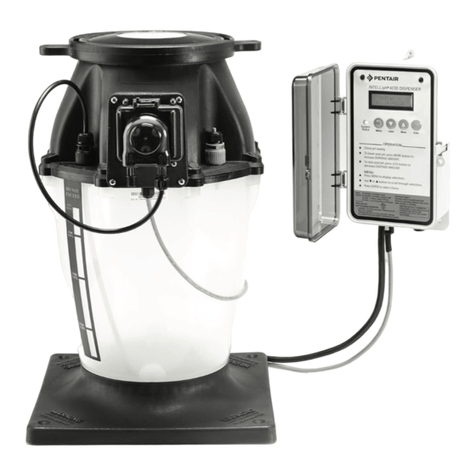
SAFETY INSTRUCTIONS
For professional use only. Osbserve
allwarnings. Read and unserstand all
instructions before operating equip-
ment. Extreme caution should beused
when operating this equipment asper-
sonol injury and/or property damage
can result from equipment misuse.
Adequate protection isrecommended
toprevent splashing ofmaterial onto
the skin orinto the eyes.
WARNING
WARNING
NEVER point dispensing
valve atany part ofthe body or
atanother person.
PRESSURE RELIEF
PROCEDURE
Toreduce the risk ofserious
bodily injury, including splash-
ing into the eyes or onto the
skin, always follows this proce-
dure When ever you shut off the
pump, when checking or serv-
icing any part of the system,
and when installing, cleaning
or changing any part of the
system.
1. Disconnect air to the pump.
2. Point the dispensing valve
away from yourself and
others.
3. Open the dispensing valve
into an appropriate container
until pressure is relieved.
If you suspect that the dis-
pensing valve or hose is com-
pletely clogged orthat pressure
has not been fully relieved after
following the above procedure,
VERY SLOWLY loosen the hose
end coupling to relieve pressure
gradually, then loosen comple-
tely. Now clear the valve or
hose.
WARNING
WARNING
NEVER trytostop ordeflect
material from dispensing valve
orleakig connection orcom-
ponent with your hand orbody.
WARNING
ALWAYS check equipment
forproper operation before each
use, making sure safety devices
are inplace and operating porp-
erly. DONOT after ormodify
any part ofequipment as
this may cause amalfunction
and result inserious bodily
injury.
INSPECTION
INSTRUCTIONS
WARNING
ALWAYS follow the pressure
relief procedure after shutting
offthe pump, when checking
orservicing any part ofthe sys-
tem; and when installing, clean-
ing orchanging any part ofthe
system.
If overpressurizing of the equipment
is believed to hav occurred, contact the
factory authorized warranty and service
center nearest you for inspection of the
pump.
Specialized equipment and knowl-
edge is required for repair of this pump.
Contact the factory authorized warranty
and service center nearest you for repair
or adjustments other than maintenance
specified in this manual.
Annual inspection by the factory
authorized warranty and service center
nearest you is recommended.
Alist of factory authorized warranty
and service centers is available upon
request.
DAMAGED PUMPS
Any pump that appears to be damaged
in any way, is badly worn or operates
abnormally shall be removed from use
until repairs are made. Contact the
factory authorized warranty and service
center nearest you for repairs.
INSTALLATION
The typical installation shown is only
aguide for selecting and installing sys-
tem components. Contact your Lincoln
Representative for assistance in design-
ing asystem to suit your specific needs.
An air line filter/regulator/lubricator
isrecommended for use with your Lincoln
pump to remove harmful dirt and mois-
ture from the Compressed air supply,
and to provide automatic lubrication to
the air motor.
This pump can develop 600
PSl working pressure at 200
PSl maximum incoming air
pressure. Be sure that all sys-
tem equipment and accessories
are rated to withstand the maxi-
mum working pressure of this
pump. DO NOT exceed the
maximum working pressure of
the lowest rated component in
the system.
Flush the supply lines and hoses
with mineral spirits or oil based solvent
and blow dry with air before connecting
them to the system. This is to purge any
contaminants such as dirt, moisture, or
metal shavings that could damage the
pump or system components.
The pump was tested in lightweight
oil which was left in it to protect the
pump from corrosion. Flushing of the
pump before connecting it to the sys-
tem might be desired to prevent Pos-
sible contamination of the fluid you are
pumping.
WARNING
To reduce the risk of injury
from splashing orstatic sparking
when flushing the pump with
mineral spirits or oil based sol-
vent, always hold ametal part
of the dispensing valve firmly
to the side of agrounded metal
pail and operate pump at lowest
possible fluid pressure.
WARNING
ALWAYS read and follow the
fluid and solvent manufacture's
recommedndations regarding the
use ofprotective clothing and
equipment.



























